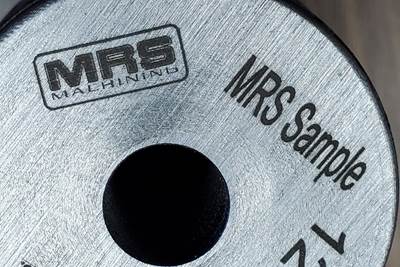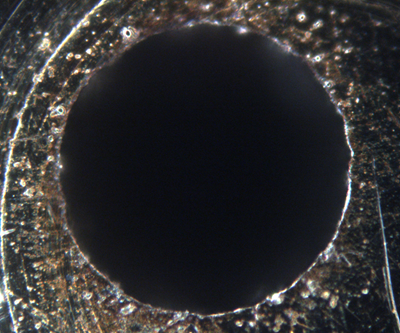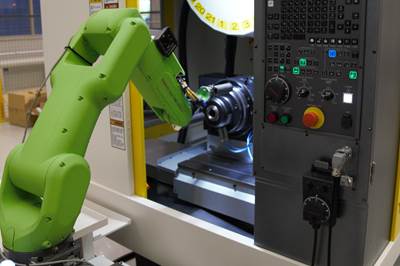5 Tips for Automating Laser Marking With Robots
Automating laser marking can be a useful way to increase robots’ utilization, but the process requires careful planning for success.
Share





Hwacheon Machinery America, Inc.
Featured Content
View More.png;maxWidth=45)
DMG MORI - Cincinnati
Featured Content
View More
Takumi USA
Featured Content
View More

Autodesk, Inc.
Featured Content
View More
Automating laser marking gives robots a task during what might otherwise be their idle time — but proper integration requires careful consideration of repeatability, type of laser marking system, part temperature and other factors. Images courtesy of Laserax.
Many manufacturers aiming to improve their production rates without sacrificing precision have turned to robotic automation — especially robotic automation that performs multiple operations. One growing example of this type of deployment is the addition of automated laser marking to the work of a robot already performing machine tending. This enables the robot to perform a task during what would be idle time for machine tending, increasing the robot’s utilization and further increasing the automation cell’s productivity.
There are many ways to add automated laser marking capability to a shop floor. Three common robotic laser marking deployments include:
- Open-Air: Robots hold the part during laser marking. Open-air laser marking uses little floor space and can leverage a robot’s idle time.
- Automated Door: The robot positions the part in a laser marking machine and performs other operations during laser marking.
- Rotary Table: A dual-position rotary table allows the robot to drop a part on one side of the table, presenting the part for laser marking, while unloading another part almost simultaneously. This method ensures the robot is always busy moving parts.
Choosing between these types of setups requires careful planning and consideration of multiple factors. The following five tips should provide a general overview of the planning involved in successfully integrating an automated laser marking setup.
1. Make a Sequence Diagram
A sequence diagram for the robot’s operations provides a visual reference that maps its movement, operations and timelines for each step. Time-focused sequence diagrams map interactions and provide step-by-step charting of what happens during each phase of operation.
Not only do these diagrams illustrate what additional automation hardware is needed, they also show exactly how much time is available for laser marking. This helps with calculating the overall impact of using laser marking and finding the most efficient way to deploy it.
For example, if there are 30 seconds of robot idle time available at one phase of the process, deducting the handling time reveals how much time remains for laser marking. If the robot needs 10 seconds to position parts for laser marking, 20 seconds will remain for the marking process.
2. Consider the Entire Production Cycle
Laser marking may be a single operation in the production cycle, but it must not be treated as such. Consider how other operations might affect the laser marking process.
The most common operations that affect laser marking are surface treatments such as shotblasting, e-coating, powder coating and heat treating. These post-treatments can degrade marking legibility, making them difficult to read.
Adjusting the laser marking process can produce marks that resist post-treatments, but these adjustments usually result in longer marking cycle times. Shotblast-resistant markings, for example, can take two to three times longer to complete than regular markings. Stronger lasers can bring these longer cycle times back down, but the resulting operation should be tested before performing robotic sequencing to confirm final cycle times and prevent bottlenecks.
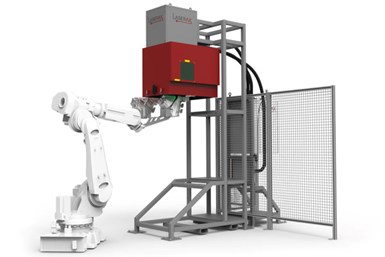
Open-air laser marking machines require little floor space and can be positioned anywhere on the shop floor, simplifying the process of integrating them with a robot.
3. Think About Shop Floor Layout
Manufacturers can easily overlook their shop floor layout and workflow when thinking about adding robotics, but accounting for floor plans and processes is essential to ensuring robots operate at their maximum efficiency.
As smaller machines are simpler to fit into an existing floor plan, shops with crowded layouts may wish to consider a small-footprint, open-air laser marking machine. Open-air designs are laser enclosures without a dedicated place to position the part, where the robot holds the part in the air during laser marking. An open-air design makes it possible to position the laser enclosure virtually anywhere, so long as the robot can reach it. Open-air machines are easy to add into existing production cells, and are a good way to leverage a robot’s precision and idle time.
Remotely located cabinets and control panels further minimize machine footprints, and using a robot’s gripper for fixturing can eliminate the need for separate equipment.
4. Consider the Robot’s Precision
Not every robot or robotic application holds the same precision. Some robot grippers are less precise than others and lead to positioning deviations that affect laser marking quality. Be sure to compare precision and repeatability between robots and grippers.
To adapt for part positioning variations, vision cameras and sensors can provide positioning feedback to either adjust the robot’s position for laser marking or adjust the laser marking process itself.
5. Consider the Part Temperature
While testing a new laser marking setup, be sure to account for part temperatures during the manufacturing process. Temperature changes alter the distance between the laser head and the part being marked, so failing to compensate can warp metal parts and induce position errors. Marking a part at 200°C will require a different amount of energy to be successful than marking a part at 15°C.
Related Content
CNC Machine Shop Honored for Automation, Machine Monitoring
From cobots to machine monitoring, this Top Shop honoree shows that machining technology is about more than the machine tool.
Read MoreWhich Approach to Automation Fits Your CNC Machine Tool?
Choosing the right automation to pair with a CNC machine tool cell means weighing various factors, as this fabrication business has learned well.
Read MoreCutting Part Programming Times Through AI
CAM Assist cuts repetition from part programming — early users say it cuts tribal knowledge and could be a useful tool for training new programmers.
Read MoreSame Headcount, Double the Sales: Successful Job Shop Automation
Doubling sales requires more than just robots. Pro Products’ staff works in tandem with robots, performing inspection and other value-added activities.
Read MoreRead Next
A Marked Part Is Never Lost
Laser engraving parts has become an essential process at MRS Machining. Marked parts mean that both the manufacturer and the customer are protected from misidentifying parts.
Read MoreFiber Laser Markers Do Much, Much More
Fiber laser technology is not just for marking—used properly, it can alleviate the burden on milling, EDM and welding equipment.
Read MoreAvoiding a Failed Automation Integration
New features that simplify robot use have blurred the lines between tasks that shops can automate independently from those that will require the support of an integrator. Here’s what shops should keep in mind to avoid a costly failed integration.
Read More





















.png;maxWidth=150)


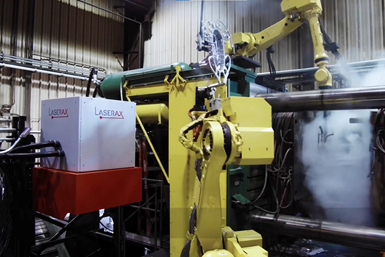













.jpg;maxWidth=300;quality=90)





